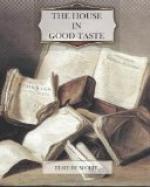A general rule to follow in a small house is: do not have a figured wall paper if you expect to use things of large design in your rooms. If you have gorgeous rugs and hangings, keep your walls absolutely plain. In furnishing the Colony Club I used a ribbon grass paper in the hallway. The fresh, spring-like green and white striped paper is very delightful with a carpet and runner of plain dark-green velvet, and white woodwork, and dark mahogany furniture, and many gold-framed mirrors. In another room in this building where many chintzes and fabrics were used, I painted the woodwork white and the walls a soft cream color. In the bedrooms I used a number of wall papers, the most fascinating of these, perhaps, is in the bird room. The walls are hung with a daringly gorgeous paper covered with birds—birds of paradise and paroquets perched on flowery tropical branches. The furniture in this room is of black and gold lacquer, and the rug and hangings are of jade green. It would not be so successful in a room one lived in all the year around, but it is a good example of what one can do with a tempting wall paper in an occasional room, a guest room, for instance.
Some of the figured wall papers are so decorative that they are more than tempting, they are compelling. The Chinese ones are particularly fascinating. Recently I planned a small boudoir in a country house that depended on a gay Chinoiserie paper for its charm. The design of the paper was made up of quaint little figures and parasols and birds and twisty trees, all in soft tones of green and blue and mauve on a deep cream ground. The woodwork and ceiling repeated the deep cream, and the simple furniture (a day bed, a chest of drawers, and several chairs) were of wood, painted a flat blue green just the color of the twisty pine-trees of the paper.
We had a delightful time decorating the furniture with blue and mauve lines, and we painted parasols and birds and flowers on chair backs and drawer-knobs and so forth. The large rug was of pinky-mauve-gray, and the coverings of the day bed and chairs were of a mauve and gray striped stuff, the stripes so small that they had the effect of being threads of color. There were no pictures, of course, but there was a long mirror above the chest of drawers, and another over the mantel. The lighting-fixtures, candlesticks and appliques, were of carved and painted wood, blue-green with shades of thin mauve silk over rose.
Among the most enchanting of the new papers are the black and white ones, fantastic Chinese designs and startling Austrian patterns. Black and white is always a tempting combination to the decorator, and now that Josef Hoffman, the great Austrian decorator, has been working in black and white for a number of years, the more venturesome decorators of France, and England and America have begun to follow his lead, and are using black and white, and black and color, with amazing effect. We have black papers patterned




